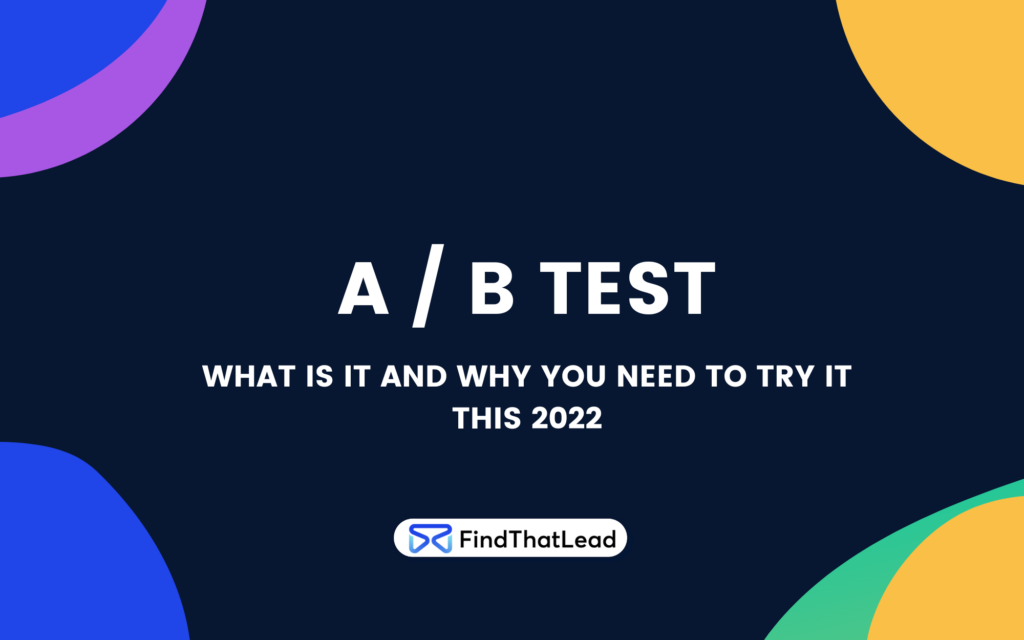As email marketing is going through its revival period, many people claim to be experts in this field. What a chaos this creates!
On the one hand, it’s absolutely disastrous. On the other hand, it allows us to apply chaos theory to the realities of email marketing. The butterfly effect, in particular: a small change in one state of a deterministic nonlinear system can lead to big differences in a later state.
In other words, just so you understand, email as a marketing asset is so intricate that even the smallest change can make the whole campaign a success! 😏
Now that we are going through a post-pandemic crisis, the last thing you want to happen is for your cold email campaign to fail, which is why you need to be especially careful with all changes you make. That’s why you need to be especially careful with all the changes you make – ideally, you should back up all your email marketing decisions with data! 💙
One way to get that data is to A / B test your cold emails, here is the perfect guide! 😏
In general, what is A / B testing?
A / B testing, also known as split testing, is a marketing experiment in which you split your audience to test a number of variations of a campaign to determine which one works best. In other words, you can show version A of a piece of marketing content to one half of your audience and version B to another.
⭐ Tip:A/B testing can be valuable because different audiences behave, well, differently! 😎
What is Test A/B in Email Marketing?
A/B testing, in the context of email, refers to the process of sending one variation of your email campaign to one part of the subscribers on your mailing list and a different variation to another part of the subscribers.
The goal of A/B testing is to identify which variation of the element shows the best results and use it to craft the ultimate email campaign (i.e., the best one 😉).
Why do you need to A/B test your cold emails?
A/B testing has a wide range of benefits that can make your cold email campaign significantly more effective:
It helps you understand what your subscribers want.
You must remember that the ultimate goal of every marketing resource you create is to attract your target audience!
Even if you personally think that the cold email you’ve crafted is above and beyond anything else (which I don’t doubt), it’s important to remember that the ultimate goal of every marketing resource you create is to engage your target audience 🙄), you can’t just send it immediately and call it a day. It’s mandatory to get a second opinion from your subscribers first.
⭐ Tip: The final word is always left to the final recipients of the emails in question. By letting your subscribers decide what works best for them, you increase the chances that your cold emails will be tailor-made and tailored to your potential customers..
Maintain a competitive advantage
A couple of years ago, A/B testing of emails was not as common as it is today. Back in the day, doing so gave you a competitive advantage and differentiated you from other companies in your industry. Today, it is no longer an option but a necessity!
⭐ Tip: All your competitors are doing A/B testing with their email marketing campaigns, which means you must match your efforts if you want to be on par with them 🤓.
It’s accurate
You can always use your logic when evaluating how different elements of your email campaign can affect your prospects. There is a lot of information out there about the effects of different email marketing elements on the success of a campaign. However, there will always be a bias in your assumptions! Hint: Logic doesn’t always work 🙄.
⭐ Tip: First, people tend to be less harsh on your own creations. Secondly, you can never be sure that something that works well for your colleagues will have the same results for you. In contrast, an A/B test gives you hard facts and figures on which to base your subsequent analysis. 😎.
It is cost-effective and time-efficient
Since you have access to all the information about your target audience’s response, you can quickly discontinue those that do not generate the expected ROI.
Also, when you perform an A/B test, you save time that would otherwise have been wasted on a strategy that does not convert 💔.
Helps to increase open and click-through rates.
An A/B test helps identify common trends and preferences among your target audience and target them more effectively.
⭐ Tip:Knowing their likes and dislikes, you can craft an email that takes them into account 😉.
Enables you to turn more prospects into customers
With higher CTR and open rates, you have the opportunity to generate more revenue as more people act on the CTA in your email 💙.
A/B Testing Process
Here is the A/B testing process you can use to get started!
1. Collect data
Your analytics will often provide you with information on where you can start optimizing. It’s helpful to start with the high traffic areas of your site or application so you can gather data more quickly.
⭐ Tip: Look for pages with low conversion rates or high abandonment rates that can be improved.
2. Identify goals
Your conversion goals are the metrics you use to determine if the variation is more successful than the original version.
⭐ Tip: Objectives can be anything from clicking a button or link to purchasing a product or subscribing to an email.
3. Generate hypotheses
Once you’ve identified a goal, you can start generating A/B test ideas and hypotheses as to why you think they’ll be better than the current version. Once you have a list of ideas, prioritize them in terms of expected impact and difficulty of implementation.
4. Create variations
Make the desired changes! This could be changing the color of a button, swapping the order of elements on the page, hiding navigation elements or something completely custom.
⭐ Tip: Many of the major A/B testing tools have a visual editor that will facilitate these changes, so be sure to perform a quality control check of your experiment to make sure it works as expected! 😉
5. Run the experiment
Run your experiment and wait for visitors to participate! 💙
6. Analyze the results
Once the experiment is completed, it is time to analyze the results 🤓.
Mostly, your A/B testing software will present the data from the experiment and show you the difference between the performance of the two versions and whether there is a statistically significant difference.
⭐ Tip: You can also view the results of each campaign manually with your Cold Email software and compare the feedbacks of each version yourself.
If your variation is the winner, congratulations! 😍
If your experiment generates a negative result or no result, don’t worry. Use the experiment as a learning experience and generate new hypotheses that you can test. 😎.
How to A/B test an Email Cold Email
1. Subject lines
We know it’s a mistake to judge the book by its cover, but we simply can’t help ourselves. The book cover is the first thing you see in the store when you’re trying to find your next read, so it’s only fair that you make an initial judgment based entirely on it🤷🏼♂️.
¡Lo mismo ocurre con los correos electrónicos! Cuando un nuevo correo electrónico llega a tu bandeja de entrada, no ves su contenido al principio. Lo único que puedes ver en ese momento es la línea de asunto. Por eso la primera impresión es importante 👀.
⭐ Tip:Your goal is to strike the perfect balance between information and intrigue, without click-baiting your way onto the recipient’s reading list. If your email doesn’t deliver what it promises, you’ll face accusations of going straight to spam 💔.
Yes, a successful subject line is the backbone of your campaign. That’s why you should strive for it: your whole campaign depends on it! Here are some subject line A/B testing ideas for you to try:
1. Personalization
Emails with personalized subject lines are 26% more likely to be opened.
⭐ Tip: While modern personalization goes far beyond simply incorporating the recipient’s name in the subject line or body of the email, it’s still a good place to start.
In fact, according to a Campaign Monitor study on powerful words in email subject lines, including the person’s name in the subject line can lead to a 14% increase in open rate 🤯.
⭐ Tip:With our Email Sender tool, you will not only create campaigns easier than ever, but you will also be able to customize them as you want and get all the specific results of each one of them.
Any variation of the first name can bring positive results to your email campaign. But remember that the effectiveness of using just the first name or just the last name, or a combination of both, varies from industry to industry – you need to test both options and see which works best for you!
⭐ Tip:Run an A/B test with two subject lines, with one variant using the recipient’s name and the other omitting it. If you find that the custom subject line works better, run additional tests to determine which type of name generates the highest open rates.
2. Ambiguous versus specific benefits
The person’s name may be the sweetest sound to your ears, but the notion of potential benefits is close behind 😎.
One of the first rules for creating a subject line that encourages your subscribers to click on the email is to state exactly how they will benefit from doing so. You have to offer a promise of value from the very first word. Otherwise, it will be a waste of time and they won’t open your message.
⭐ Tip: The trick is… To each his own. As the author of the email, you sincerely believe that all the content you create is worthy of attention and brings a lot of value to whoever interacts with it. The truth, however, may be something different. Just because you think something is best for your audience, doesn’t mean they necessarily agree 😉.
If your email campaign offers multiple benefits to subscribers, you should A/B test all of them to see which one has the most value. Spoiler alert: it’s not always the most obvious one 💔.
⭐ Tip: If your email contains several benefits for the email recipient, try different benefits in your subject lines without changing anything else.
3. Subject line length
Brevity is the soul of wit. It always has been, but now it is even more so! 😎
People are increasingly inclined to use smartphones to check their emails instead of reading their morning mail at their desk. In fact, approximately 85% of users today use smartphones to access email.
This means there may be display issues on different devices and browsers!
⭐ Tip: Do A/B tests with different subject lines that convey the same message but with a different number of words and characters: make one of them short and the other long!
4. Emojis vs No emoji
There is a whole debate about whether emojis are a hit or a miss in 2022. Some claim that emojis are the lord and savior of email marketing, while others have long since given up on emoji hype and consider them old-fashioned and tasteless 🤷🏼♂️.
In any case, there is no denying the fact that emojis are a great workaround for the character limit of the subject line (you can easily replace a complete emotion with a small emoji). Plus, they help your emails stand out in the inbox.
Eyes are immediately diverted to subject lines with emojis. So you can be sure that your email will be seen 😎.
2. Copy
Getting your email opened is only a half-hearted job. After all, the ultimate goal of your email campaign is to motivate subscribers to take action, which requires them to read the text! 😉
Some of the essential elements of the body of the email are
Tone and voice: There are many different ways to convey the same information. Altering the tone and voice you use when conveying the message can change the message itself. It all depends on which aspects you emphasize.
Length: The longer the better? Could be. But apparently not in email marketing. Since smartphones and the Internet, people’s attention spans have dwindled to less than 8 seconds – that’s one second shorter than a goldfish. While it may not bother you in everyday life, it’s definitely something you need to be aware of as a marketer.
Visuals: You also need to be careful with visuals. While it’s a great idea to incorporate a couple of images in the text to liven up the email a bit, you have to remember that they don’t always display correctly.
3. CTA
It is imperative that the CTA of your email is well defined if you want to encourage your subscribers to act on reading your email. Otherwise, it’s a waste of money!
⭐ Tip: To make sure your subscribers take the action you expect them to take (whether it’s joining a community, downloading an eBook, watching a video or buying a product), you need to show them the right direction!
The only way to do that is to include a call to action: a well-designed CTA is your best friend. But there’s a lot of controversy about what constitutes a good CTA:
- Form
- Button or text
- Length
- Colors
- Positioning
⭐ Tip: You can then try A/B testing common best practices with the subscribers on your mailing list to find the one that generates the most conversions. Remember, even the smallest change can cause a butterfly effect!
4. Mailing schedules
Last but not least, you must find the most optimal time to send your Cold Emails. Even if the rest of your email campaign is perfect, sending it at the wrong time can ruin all your efforts and result in an unsuccessful campaign 💔.
Remember that in order to run a Cold Email campaign, you must first have a valuable list, if possible, of your potential customers.
And don’t forget to use a software that helps you with all your email marketing campaigns and also gives you all the information you need to perform worthwhile A/B tests: Try Email Sender!







 BONUS:
BONUS: The Challenge: Join this free course and I guarantee that after 5 days you will have the necessary skills to start generating B2B clients Growth Hacking and Prospecting techniques.
The Challenge: Join this free course and I guarantee that after 5 days you will have the necessary skills to start generating B2B clients Growth Hacking and Prospecting techniques.